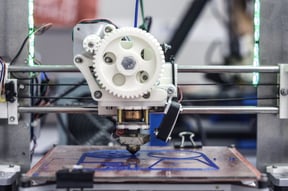Technology has long been a driving force behind the advancement of manufacturing innovation. New types of machines and processes give manufacturers new tools to improve their use of time, l

abor, and material resources. This, in turn, helps to make manufacturers more productive and efficient.
However, it can often be hard to determine how much of an impact any new technology might have on the American manufacturing industry until that technology has had the chance to be applied by a large number of manufacturers.
In a recent publication, Stratsys Direct Manufacturing investigated the potential impact of 3D printing (a.k.a. additive manufacturing) technology on the manufacturing industry by surveying “700 degreed engineers, executives, designers and project managers” that are “already using 3D printing in their manufacturing processes or plan to do so in the next three years.”
So, what are some of the findings from the study? How is additive manufacturing expected to affect the manufacturing industry over the next few years?
1: 3D Printing Allows for More Complex Designs
One of the key findings of the survey was that most (79%) manufacturers saw “more complex design capabilities” as one of the most significant benefits of using 3D printing technology.
Because of the way the additive manufacturing process works, wherein an object is “printed” layer by layer, it is possible to make solid, highly-complicated parts with internal shapes that would have been impossible to make using an injection mold.
Previously, such shapes would have had to be created separately and inserted into the part, which would reduce the rigidity of the final work piece and require extra assembly processes.
2: Lead Time for Parts Will Be Reduced
Another benefit that a majority (76%) of respondents to the survey noted as being significant was that additive manufacturing technology led to a “reduced lead time for parts.”
How is it that 3D printing technology allows for the faster production of parts? There are a couple of factors that help contribute to the reduced lead time for parts.
First, as was mentioned in the previous section, the layer-by-layer construction method used by 3D printers allows for incredibly complicated parts to be assembled as a single, solid piece. This eliminates the need to manufacture multiple parts that need to be assembled later. In effect, this reduces the creation of some complicated parts to a single process.
Second, most 3D printers can be switched from making one kind of part to another without needing special tooling beyond changing the materials being fed into the extruders and setting up the manufacturing program.
With traditional machines, special tooling may have to be custom-manufactured and installed before work on manufacturing a part can begin, which adds time, labor, and other costs to the process.
3: Metal Printing Technology is Highly Sought by Manufacturers in a Variety of Industries
According to the survey results, “metals are most highly-coveted across all industries, with 84% of respondents interested in seeing more metal material development.” The runner-up was rubber-like materials at 61%.
Why are metals so highly sought after?
There are a number of possible reasons, from the high tensile strength of some metals, to their corrosion resistance, temperature resistance, or even their magnetic properties.
However, these properties are all different from one metal alloy to the next. Because of this fact, it’s difficult to say what the survey respondents were most looking for in this category of materials without knowing the specific alloys they were interested in seeing developed for additive manufacturing.
4: Use of 3D Metal Printing is Expected to Double Over the Next Three Years
According to the survey results, Stratasys projects that “additive metal use is expected to nearly double over the next 3 years.”
The relatively recent introduction of laser sintering technology that allows for additive manufacturing with metal materials may be a large part of the reason why 3D printing using metal is expected to grow so much in the next few years.
As this technology becomes more commonplace and affordable, we might see more manufacturers acquire the equipment to handle 3D metal printing in-house.
However, the prediction for the near future made by Stratasys states that “the market is more likely to turn to service providers for access to additive metal technologies rather than buy equipment and build the required team and skills.” In other words, most members of the manufacturing industry are probably going to outsource 3D metal printing tasks rather than handling them in-house.
Why?
For now, acquiring the equipment to handle this process on an industrial scale remains expensive, so it would not be worth it for most manufacturers to buy this equipment to make a one-off part or limited production run.
Overall, 3D printing has an enormous amount of potential for American manufacturers. While we won’t know the full impact of this technology right away, we can all look forward to finding out and taking advantage of this technology to be more productive and efficient than ever before.



.gif)


